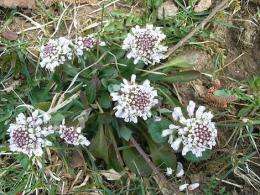Wildflower uses self-imposed armour to fight off disease

An unusual wildflower that accumulates metals in its leaves has been found to use them as a kind of 'armour' against bacterial infection.
Alpine pennycress (Thlaspi caerulescens) is a small plant in the mustard family that grows on metal-rich soils scattered around Britain and Europe, such as the sites of former mine workings. The plant is known to accumulate zinc, nickel and cadmium to very high concentrations in its leaves, but why it should do this has remained a mystery.
Now scientists from Oxford University have shown that when Thlaspi plants accumulate metals in their leaves they become resistant to attack by the bacterium Pseudomonas syringae pv. maculicola. They report their findings in the journal PLoS Pathogens.
‘Our results demonstrate that these plants are exploiting their metal-rich environment to armour themselves against disease,’ said Dr. Gail Preston of Oxford University’s Department of Plant Sciences, co-author of the report. ‘What we’ve found is a direct link between these high metal concentrations and resistance to bacterial infection.’
Helen Fones, the graduate student who carried out the experimental work, cultivated Thlaspi plants on progressively higher concentrations of zinc, nickel and cadmium and showed that all three metals were able to defend the plant against the pathogenic bacterium. By studying diverse strains of the bacterium, she was able to demonstrate a close relationship between the ability of bacteria to grow in the presence of high concentrations of metal and their ability to infect the plants.
'Previously, it has been difficult to explain why Thlaspi plants should accumulate such high concentrations of potentially toxic metals,’ said Professor Andrew Smith of Oxford’s Department of Plant Sciences, co-supervisor of the research. ‘Our findings provide good evidence that, by accumulating metals, these plants benefit from enhanced protection against enemies such as pathogenic microorganisms and herbivores.’
The researchers also showed that bacteria surviving on Thlaspi plants on the site of a former lead-zinc mine in Wales had a higher tolerance for zinc than bacteria isolated from plants growing on normal soils. This indicates that both the plant and its pathogens show evidence of local adaptation to survival in metal-rich environments, and that pathogens can adapt to overcome plant defences based on metals. Dr. Preston said: ‘Heavy metals may be part of an evolutionary ‘arms race’ between plants and the microorganisms that try to colonise them.’
More information: Fones H, Davis CAR, Rico A, Fang F, Smith JAC, et al. (2010) Metal Hyperaccumulation Armors Plants against Disease. PLoS Pathog 6(9): e1001093. doi:10.1371/journal.ppat.1001093
Provided by Oxford University
















